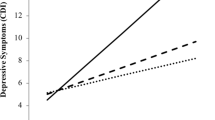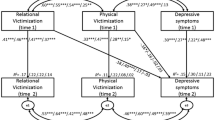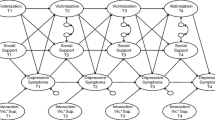Abstract
Adolescence heralds a unique period of vulnerability to depressive symptoms. This longitudinal study examined relational victimization in adolescents’ peer relationships as a unique predictor of depressive symptoms among a primarily (85%) Caucasian sample of 540 youth (294 females) concurrently and across a 6-year period. The moderating effects of emotional support received from mothers, fathers, and peers on the association between relational victimization and adolescents’ depressive symptoms were also investigated. Findings revealed that adolescents who were relationally victimized consistently had higher depressive symptoms than their non-victimized peers. However, high levels of emotional support from fathers buffered this relationship over time. Emotional support from mothers and peers also moderated the longitudinal relationship between relational victimization and depressive symptoms, with high levels of support predicting increases in adolescents’ symptoms. Relational victimization presents a clear risk for depressive symptoms in adolescence, and emotional support may serve either a protective or vulnerability-enhancing role depending on the source of support.



Similar content being viewed by others
References
Aiken, L. S., & West, S. G. (1991). Multiple regression: Testing and interpreting interactions. London, England: Sage.
Baldry, A. C. (2004). Mental and physical health of Italian youngsters directly and indirectly victimized at school and home. International Journal of Forensic Mental Health, 3, 77–91.
Barber, B. K. (1996). Parental psychological control: Revisiting a neglected construct. Child Development, 67, 3296–3319.
Barber, B. K., & Harmon, E. L. (2002). Violating the self: Parent psychological control of children and adolescents. In B. K. Barber (Ed.), Intrusive parenting: How psychological control affects children and adolescents (pp. 15–52). Washington, DC: American Psychological Association.
Baron, R. M., & Kenny, D. A. (1986). The moderator-mediator variable distinction in social psychological research: Conceptual, strategic, and statistical considerations. Journal of Personality and Social Psychology, 51(6), 1173–1182.
Barrera, M., & Garrison-Jones, C. (1992). Family and peer social support as specific correlates of adolescent depressive symptoms. Journal of Abnormal Child Psychology, 20, 1–16.
Bond, L., Carlin, J. B., Thomas, L., Rubin, K., & Patton, G. (2001). Does bullying cause emotional problems? A prospective study of young teenagers. British Medical Journal, 323, 480–484.
Boyce, W. F. (2006). Young people in Canada: Their health and well-being. Health Canada Report.
Calmes, C. A., & Roberts, J. E. (2008). Rumination in interpersonal relationships: Does co-rumination explain gender differences in emotional distress and relationship satisfaction among college students? Cognitive Therapy and Research, 32, 577–590.
Carbonell, D. M., Reinherz, H. Z., & Giaconia, R. M. (1998). Risk and resilience in late adolescence. Child and Adolescent Social Work Journal, 15(4), 251–272.
Cohen, S., & Wills, T. A. (1985). Stress, social support, and the buffering hypothesis. Psychological Bulletin, 98, 310–357.
Colarossi, L. G., & Eccles, J. S. (2003). Differential effects of support providers on adolescents’ mental health. Social Work Research, 27, 19–30.
Collins, W., & Laursen, B. (2004). Parent-adolescent relationships and influences. In W. Collins & B. Laursen (Eds.), Handbook of adolescent psychology (2nd ed.). Hoboken, NJ: Wiley.
Cowie, H. (2000). Bystanding or standing by: Gender issues in coping with bullying in English schools. Aggressive Behavior, 26, 85–97.
Craig, W. M. (1998). The relationship among bullying, victimization, depression, anxiety, and aggression in elementary school children. Personality and Individual Differences, 24(1), 123–130.
Crick, N. R. (1995). Relational aggression: The role of intent attributions, feelings of distress, and provocation type. Development and Psychopathology, 7, 313–322.
Crick, N. R., & Bigbee, M. A. (1998). Relational and overt forms of peer victimization: A multiinformant approach. Journal of Consulting and Clinical Psychology, 66(2), 337–347.
Crick, N. R., Casas, J. F., & Ku, H. C. (1999). Relational and physical forms of peer victimization in preschool. Developmental Psychology, 35(2), 376–385.
Crick, N. R., & Grotpeter, J. K. (1995). Relational aggression, gender, and social-psychological adjustment. Child Development, 66, 710–722.
Crick, N. R., & Grotpeter, J. K. (1996). Children’s treatment by peers: Victims of relational and overt aggression. Development & Psychopathology, 8(2), 367–380.
Crick, N. R., Nelson, D. A., Morales, J. R., Cullerton-Sen, C., Casas, J. F., & Hickman, S. (2001). Relational victimization in childhood and adolescence: I hurt you through the grapevine. In J. Juvonen & S. Graham (Eds.), School-based peer harassment: The plight of the vulnerable and victimized (pp. 196–214). New York: Guildford Press.
Cumsille, P. E., & Epstein, N. (1994). Family cohesion, family adaptability, social support, and adolescent depressive symptoms in outpatient clinic families. Journal of Family Psychology, 8, 202–214.
Cunningham, C. E., Harrison, R., Knight, R., McHolm, A., Pollard, L., & Ricketts, P. (2007). The Brief Child and Family Phone Interview (BCFPI) in Hamilton: Intake Screening, triaging, outcome measurement, and program management. Psychology Ontario, 8–10.
Day, R. D., & Padilla-Walker, L. M. (2009). Mother and father connectedness and involvement during early adolescence. Journal of Family Psychology, 23(6), 900–904.
Furman, W., & Buhrmester, D. (1992). Age and sex differences in perceptions of networks of personal relationships. Child Development, 63, 103–115.
Galambos, N. L., Leadbeater, B. J., & Barker, E. T. (2004). Gender differences in and risk factors for depression in adolescence: A 4-year longitudinal study. International Journal of Behavioral Development, 28, 16–25.
Grossmann, K., Grossmann, K. E., Fremmer-Bombik, E., Kindler, H., Scheuerer-Englisch, H., & Zimmermann, P. (2005). The uniqueness of the child-father attachment relationship: Fathers’ sensitive and challenging play as a pivotal variable in a 16-year longitudinal study. Social Development, 11(3), 307–331.
Hawker, D. S., & Boulton, M. J. (2000). Twenty years’ research on peer victimization and psychosocial maladjustment: A meta-analytic review of cross-sectional studies. Journal of Child Psychology and Psychiatry, 41(4), 441–455.
Helsen, M., Vollebergh, W., & Meeus, W. (2000). Social support from parents and friends and emotional problems in adolescence. Journal of Youth and Adolescence, 29(3), 319–335.
Hodges, E. V. E., Boivin, M., Vitaro, F., & Bukowski, W. M. (1999). The power of friendship: Protection against an escalating cycle of peer victimization. Developmental Psychology, 35, 98–101.
House, J. S., Kahn, R. L., McLeod, J. D., & Williams, D. (1985). Measures and concepts of social support. In S. Cohen & S. L. Syme (Eds.), Social support and health. New York: Academic Press.
Klerman, G. L., Weissman, M. N., Rounsaville, B. J., & Chevron, E. S. (1984). Interpersonal psychotherapy of depression. New York: Basic Books.
Leadbeater, B. J., Blatt, S. J., & Quinlan, D. M. (1995). Gender-linked vulnerabilities to depressive symptoms, stress, and problem behaviors in adolescents. Journal of Research on Adolescence, 5, 1–29.
Leadbeater, B. J., Boone, E. M., Sangster, N. A., & Mathieson, L. C. (2006). Sex differences in the personal costs and benefits of relational and physical aggression in high school. Aggressive Behavior, 32, 409–419.
Leadbeater, B. J., Kuperminc, G. P., Blatt, S. J., & Hertzog, C. (1999). A multivariate model of gender differences in adolescents’ internalizing and externalizing problems. Developmental Psychology, 35, 1268–1282.
Leadbeater, B. J., & Way, N. (2001). Growing up fast: Transitions to early adulthood of inner-city adolescent mothers. New Jersey: Lawrence Erlbaum Associates. Mahwah.
Meece, D., & Laird, R. D. (2006). The importance of peers. In F. A. Villarruel & T. Luster (Eds.), The crisis in youth mental health: Critical issues and effective programs (vol 2): Disorders in adolescence. Westport, CT: Praeger Publishers.
Nansel, T. R., Overpeck, M., Pilla, R. S., Ruan, W. J., Simons-Morton, B., & Scheidt, P. (2001). Bullying behaviors among US youth: Prevalence and association with psychosocial adjustment. Journal of the American Medical Association, 285(16), 2094–2100.
Newcomb, M. D. (1990). Social support and personal characteristics: A developmental and interactional perspective. Journal of Social and Clinical Psychology, 9, 54–68.
NICHD Early Child Care Network (2004). Trajectories of physical aggression from toddlerhood to middle childhood: Predictors, correlates, and outcomes. Monographs of the Society for Research in Child Development, serial no. 279, p. 69.
Nolen-Hoeksema, S. (2006). Gender differences in depression. In I. H. Gotleib & C. L. Hammen (Eds.), Handbook of depression (pp. 492–509). New York: The Guilford Press.
Olweus, D. (1993). Bullying at school. Cambridge, UK: Blackwell.
Peterson, G. W. (2005). Family influences on adolescent development. In T. P. Gullotta & G. R. Adams (Eds.), Handbook of adolescent behavioral problems. New York: Springer.
Phares, V., Fields, S., Kamboukos, D., & Lopez, E. (2005). Still looking for poppa. American Psychologist, 60, 735–736.
Prinstein, M. J., Boergers, J., & Vernberg, E. M. (2001). Overt and relational aggression in adolescents: Social-psychological adjustment of aggressors and victims. Journal of Clinical Child Psychology, 30(4), 479–491.
Procidano, M. E., & Heller, K. (1983). Measures of perceived social support from friends and family: Three validation studies. American Journal of Community Psychology, 11, 1–24.
Rose, A. J. (2002). Co-rumination in the friendships of girls and boys. Child Development, 73(6), 1830–1843.
Rudolph, K. D., & Hammen, C. (1999). Age and gender as determinants of stress exposure, generation, and reactions in youngsters: A transactional perspective. Child Development, 70(3), 660–677.
Rudolph, K. D., Hammen, C., Burge, D., Lindberg, N., Herzberg, D., & Daley, S. E. (2000). Toward an interpersonal life-stress model of depression: The developmental context of stress generation. Development and Psychopathology, 12, 215–234.
Schaefer, E. (1965). Children’s reports of parental behavior: An inventory. Child Development, 36, 413–424.
Schraedley, P. K., Gotlib, I. H., & Hayward, C. (1999). Gender differences in correlates of depressive symptoms in adolescents. Journal of Adolescent Health, 25, 98–108.
Seals, D., & Young, J. (2003). Bullying and victimization: Prevalence and relationship to gender, grade level, ethnicity, self-esteem, and depression. Adolescence, 38(152), 735–747.
Slavin, L. A., & Rainer, K. L. (1990). Gender differences in emotional support and depressive symptoms among adolescents: A prospective analysis. American Journal of Community Psychology, 18(3), 407–421.
Smetana, J. G., Metzger, A., Gettman, D. C., & Campione-Barr, N. (2006). Disclosure and secrecy in adolescent-parent relationships. Child Development, 77, 201–217.
Stalets, M. M., & Luby, J. L. (2006). Preschool depression. Child and Adolescent Psychiatric Clinics of North America, 15(4), 899–917.
Sterba, S. K., Prinstein, M. J., & Cox, M. J. (2007). Trajectories of internalizing problems across childhood: Heterogeneity, external validity, and gender differences. Development and Psychopathology, 19(2), 345–366.
Stice, E., Ragan, J., & Randall, P. (2004). Prospective relations between social support and depression: Differential directions of effects for parent and peer support? Journal of Abnormal Psychology, 113, 155–159.
Storch, E. A., Phil, M., Nock, M. K., Masia-Warner, C., & Barlas, M. E. (2003). Peer victimization and social-psychological adjustment in Hispanic and African-American children. Journal of Child and Family Studies, 12(4), 439–452.
Tomarken, A. J., & Waller, N. G. (2005). Structural equation modeling: Strengths, limitations, and misconceptions. Annual Review of Clinical Psychology, 1, 31–65.
Videon, T. M. (2005). Parent-child relations and children’s psychological well-being: Do dads matter? Journal of Family Issues, 26, 55–78.
Vuijk, P., van Lier, P. A. C., Crijnen, A. A. M., & Huizink, A. C. (2007). Testing sex-specific pathways from peer victimization to anxiety and depression in early adolescents through a randomized intervention trial. Journal of Affective Disorders, 100, 221–226.
Waller, E. M., & Rose, A. J. (2010). Adjustment trade-offs of co-rumination in mother-adolescent relationships. Journal of Adolescence, 33(3), 487–497.
Way, N., & Leadbeater, B. J. (1999). Pathways toward educational achievement among African-American and Puerto-Rican adolescent mothers: Reexamining the role of social support from families. Developmental Psychopathology, 11, 349–364.
Weissman, M. M., et al. (1999). Children with prepubertal-onset major depressive disorder and anxiety grown up. Archives of General Psychiatry, 56(9), 794–801.
Williams, S. K., & Kelly, F. D. (2005). Relationships among involvement, attachment, and behavioral problems in adolescence: Examining fathers’ influence. Journal of Early Adolescence, 25, 168–196.
Yeung, R. S., & Leadbeater, B. J. (2010). Adults make a difference: The protective effects of parent and teacher emotional support on emotional and behavioral problems among peer victimized adolescents. Journal of Community Psychology, 38, 80–98.
Young, J. F., Berenson, K., Cohen, P., & Garcia, J. (2005). The role of parent and peer support in predicting adolescent depression: A longitudinal community study. Journal of Research on Adolescence, 15(4), 407–442.
Acknowledgments
The authors thank the youth who participated in this study and the researchers and research assistants affiliated with the Centre for Youth and Society at the University of Victoria. We also thank Marsha Runtz, Erica Woodin, and Joan Martin for their helpful comments on an earlier draft of the paper. This research was supported by grants from the Social Sciences and Humanities Research Council of Canada and the Michael Smith Foundation for Health Research to the first author, and by a Community Alliance for Health Research grant from Canadian Institutes of Health Research to the second author.
Author information
Authors and Affiliations
Corresponding author
Rights and permissions
About this article
Cite this article
Desjardins, T.L., Leadbeater, B.J. Relational Victimization and Depressive Symptoms in Adolescence: Moderating Effects of Mother, Father, and Peer Emotional Support. J Youth Adolescence 40, 531–544 (2011). https://doi.org/10.1007/s10964-010-9562-1
Received:
Accepted:
Published:
Issue Date:
DOI: https://doi.org/10.1007/s10964-010-9562-1




